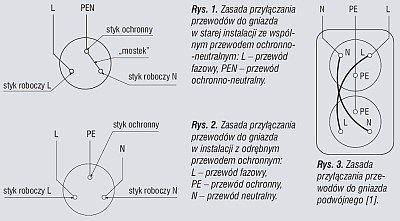Mariusz Ch. wrote: Goral-81 wrote: Mariusz Ch. wrote: Hello.
I've said it many times, but so be it. Water installations and what cannot be used as grounding.
Kisses
You can explain to me, buddy, why you say so.
http://bezel.com.pl/instalacje.html#Uziemienia
A completely different story is mentioned in a multi-sheet standard. It is about earth electrodes, not some "left earth". The earth electrode can be natural, ring, foundation .... If there are installations made of metal pipes, they are additionally connected to the equalizing rail and earth electrode.
Kisses
Buddy still does not find confirmation of your categorical NO BO NO.
And this is why, the quotation from PN-IEC 60364-5-54 is valid until 01/06/2009, but so far my sources do not have a replacement PN-HD 60364-5-54: 2007 (maybe it is different but it turns out when I get to her):
"542.2 Earths
542.2.1 The following may be used as earth electrodes:
- metal rods or pipes in the ground;
- metal strips or wires in the ground;
- metal plates in the ground;
- metal elements placed in the foundations;
- metal reinforcement for concrete;
Note - Particular care must be taken in the case of prestressed concrete structures.
-
metal water pipe systems complying with the requirements of 542.2.5
- other grounded devices suitable for this purpose (see also 542.2.6). Note - The effectiveness of a given earth electrode depends on the local ground conditions, therefore, depending on these conditions and the required resistance value, one or more earth electrodes should be used.
The value of the earth electrode resistance can be calculated or measured.
A practical guide is being prepared.
542.2.2. The type and depth of the earth electrodes should be such that the drying and freezing of the ground would not increase their resistance above the required value.
542.2.3 The materials and structures of the electrodes are to be resistant to mechanical damage caused by corrosion.
542.2.4 When designing earthing electrodes, the possibility of an increase in the resistance of the earth electrodes caused by corrosion is to be taken into account.
542.2.5 Metal water piping systems may be used as earthing electrodes, provided the consent of the entity operating the water pipelines has been obtained, and any planned changes to the water piping system are agreed with the user of the electrical system.
Note - It is recommended that the reliability of the earthing system should not depend on environmental conditions.
542.2.6 Used metal pipe systems other than those mentioned in 542.2.5 (e.g. for flammable liquids or gases, heating) shall not be used as earth electrodes intended for protective purposes. Note - This requirement does not exclude the provision of equipotential bonding with other installations and elements in use, in accordance with 41.
542.2.7 Lead sheaths and other metal sheaths of cables not exposed to damage due to excessive corrosion may be used as earth electrodes, provided that the consent of the entity operating the cables has been obtained, and the user of the electrical installation is notified of any planned change of cables, which could affect their suitability as an earth electrode. "
Moderated By Mariusz Ch.: Enough of writing nonsense. It is important to understand the difference between buried municipal water supplies and domestic plumbing.
 .
.



